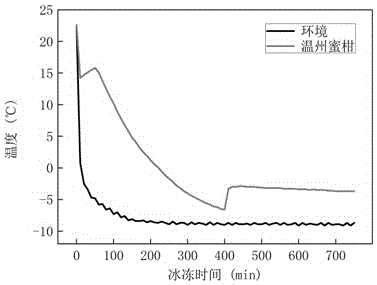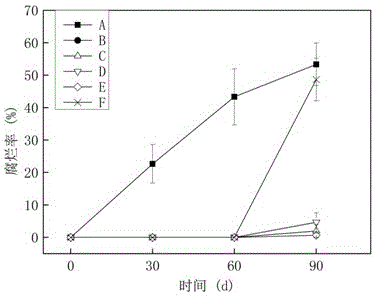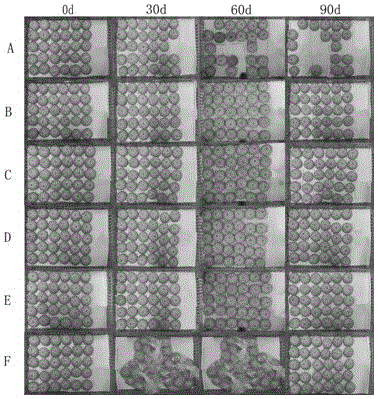Satsuma orange fruit storage method
A technology for fruit and mandarin oranges, which is applied in the field of fruit storage to achieve the effects of increasing income, easy operation and good commerciality
- Summary
- Abstract
- Description
- Claims
- Application Information
AI Technical Summary
Problems solved by technology
Method used
Image
Examples
Embodiment 1
[0022] The fruit materials used in the experiment were transported back on the day of harvest on December 6, 2014. After harvest, the fruits with uniform size, no mechanical damage, and no pests and diseases were selected and divided into 6 groups.
[0023] The first group: put it in a room at 20°C for one night, and store it directly at 9°C~12°C at 9 am the next day (treatment A);
[0024] The second group: put it in a room at 20°C for one night, and store it directly at 0°C~-2.5°C at 9 am the next day (treatment B);
[0025] The third group: on the same day, the Wenzhou satsuma fruit was soaked in 1% water-soluble chitosan solution for 60 seconds, placed in a room at 20°C to air-dry, and stored at 0°C~-2.5°C at 9 am the next day (treatment C);
[0026] The fourth group: the Wenzhou satsuma fruit was soaked in 1% vitamin solution for 60 seconds, placed in a room at 20°C to air-dry, and stored at 0°C~-2.5°C at 9 am the next day (treatment D);
[0027] The fifth group: Wenzho...
Embodiment 2
[0036] By measuring the freezing point and supercooling point of Wenzhou mandarins, the expected freezing point is -2.91°C. It can be preliminarily judged that Wenzhou mandarin oranges will not be damaged by freezing when placed in an environment of 0~-2.5°C (see figure 1 ).
[0037] The experimental results show that among the six treatments A, B, C, D, E, and F, treatments B, C, D, and E can significantly reduce the fruit rot rate of Satsuma citrus fruit compared with treatment A, and compared with other treatments, F has The fruit rot rate of Satsuma citrus was significantly reduced in the first two months, consistent with other treatments, and in the third month, the rate of rapid rot was close to that of A treatment. When stored to the third month, B, C, D, E, and F treatments all began to appear rotten fruits; while the rotten rate of B and E treatments was the lowest, both were 0.67%, while A and F treatments were relatively High decay rate, respectively 53.33% and 48....
Embodiment 3
[0041] Soluble sugar and organic acid content are one of the important qualities of Wenzhou Satsuma fruit, which are closely related to the flavor of Wenzhou Satsuma fruit. During the storage of the fruit, the flavor and quality of the fruit deteriorated. Through ice temperature storage, we found that compared with A treatment, B, C, D, E, F can maintain the original fructose, glucose, citric acid content, There is a slight upward trend in the sucrose content, and the original flavor is well maintained; while the fructose, glucose, and citric acid in treatment A generally show a declining state, and they are 19.22mg / g, 14.44mg / g, 4.78mg / g, and the sucrose treated by A also had a slight upward trend, and it was 73.56mg / g at 90 days. However, the malic acid contained in each treatment did not change significantly. Comparing the various treatments in the experiment, it can be shown that the Wenzhou citrus treated with ice temperature can better maintain the original quality and ...
PUM
 Login to View More
Login to View More Abstract
Description
Claims
Application Information
 Login to View More
Login to View More - R&D
- Intellectual Property
- Life Sciences
- Materials
- Tech Scout
- Unparalleled Data Quality
- Higher Quality Content
- 60% Fewer Hallucinations
Browse by: Latest US Patents, China's latest patents, Technical Efficacy Thesaurus, Application Domain, Technology Topic, Popular Technical Reports.
© 2025 PatSnap. All rights reserved.Legal|Privacy policy|Modern Slavery Act Transparency Statement|Sitemap|About US| Contact US: help@patsnap.com



